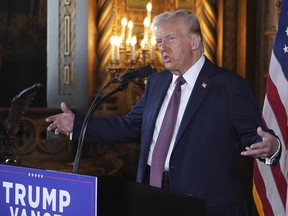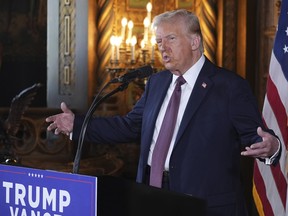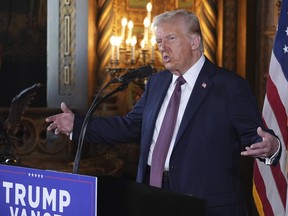A high-stakes moment in North American politics unfolded as the United States and Canada eyed the potential reshaping of their long-standing trade and security partnership. During a press conference at Mar-a-Lago, the U.S. president-elect sharpened his rhetoric about Canada, signaling that economic leverage—rather than military action—could be the tool to redefine the relationship. He floated substantial tariffs on goods from Canada and Mexico and posed a provocative question about annexing Canada, only to pivot to a concept he called “economic force.” The entourage around him framed the remarks as a bold, if controversial, assertion of American power in North America. In Ottawa, Prime Minister Justin Trudeau and his government faced a rapid-fire political test as reactions rolled in from across Canada, with opposition parties and a broad swath of the public weighing in on the idea of the United States expanding its territory through economic coercion. The episode spotlighted not only the personalities at the center of the dispute but also a wider set of questions about energy dependence, cross-border trade resilience, and Canada’s place in a continental economy that is deeply interwoven with the United States. Against this backdrop, Canadian authorities considered immediate diplomatic, economic, and strategic responses, including how to shield critical industries from potential tariff shocks, how to communicate with Canadian citizens, and how to calibrate foreign policy in a manner consistent with national interests and public sentiment.
Trump’s escalation: economic force as a tool to reshape North America
In the fulcrum of the confrontation, the central claim was that tariffs could recalibrate the balance of trade and security in North America in ways that a traditional border arrangement could not. The president-elect explicitly called for “substantial” tariffs on goods imported from both Canada and Mexico, signaling a approach to leverage economic pressure as a means to redraw the continental map more favorably toward United States interests. He underscored a preference for economic pressure rather than military force, saying that annexing Canada would be “something” if the border line were removed and viewed through a longer lens of national security. The rhetoric suggested that he believed the United States essentially protects Canada, a claim that has long circulated in political discourse in both countries but is uncommon in a policy debate characterized by pragmatic mutual benefit and interdependence.
Beyond the rhetorical flourish, the president-elect asserted that the United States was subsidizing Canada by as much as US$200 billion annually, a figure he invoked to rationalize the need for aggressive tariff policy. The implication, whether intended as an economic justification or a stronger signaling of intent, was that the United States faced meaningful and perhaps unsustainable costs embedded in the current trade arrangement. While the precise meaning of such a subsidy claim was not fully unpacked in public remarks, it touched on the broader perception in Washington that the United States bears a disproportionate burden in maintaining and financing certain cross-border economic activities. Data from U.S. sources show that the total U.S. trade deficit in goods and services with Canada stood at about US$40.6 billion in 2023, a figure that reflects a durable, though not unidirectional, pattern of bilateral trade. The narrative around subsidies fed into a broader argument about energy trade and cross-border economic dependencies that have become central to policy discussions in both capitals.
A focal point of the discussion was energy—a sector where Canada has long been a pivotal supplier to the United States. The United States imports a substantial volume of Canadian crude oil, and in certain months, the country has bought more than four million barrels per day. The energy relationship, therefore, is not a simple commodity exchange but a deeply integrated supply chain with implications for energy security, price formation, and market stability across North America. The president-elect tied this energy dynamic into his broader critique of cross-border economic arrangements, suggesting that there might be a recalibration of how North American energy is produced, marketed, and priced in a future policy framework. He did not shy away from embracing the potential to impose or threaten tariffs that would ripple through the energy market, the automotive sector, and other critical industries that rely on a seamless continental flow of goods and resources. This stance drew widespread attention from analysts who consider energy interdependence a defining feature of the bilateral relationship, as well as from industry stakeholders who track how tariff signals might affect investment, production decisions, and long-term planning.
In parallel, the remarks touched on the highly integrated continental auto supply chain, with implications for manufacturers and workers across the United States and Canada. The rhetoric suggested a reordering of where key components are produced and assembled, and it raised questions about the strategic value of domestic versus cross-border production in the automotive sector. The discussion around lumber and other raw materials added another layer: if U.S. policy sought to “un-restrict” or adjust access to certain Canadian commodities, that could, in turn, influence domestic production costs, product availability, and pricing across consumer markets in both countries. Taken together, the statements painted a vision of economic policy as a primary instrument of national strategy—an approach that would redefine how cross-border trade is managed, how critical natural resources are allocated, and how policy signals are interpreted by businesses planning investments and suppliers forging new alliances.
Canadian response: political calculations, public opinion, and leadership dynamics
In Canada, the immediate reaction was swift and multifaceted. Prime Minister Trudeau’s public stance—emphasizing that there would be no scenario in which Canada becomes part of the United States—anchored a protective and affirmative stance toward national sovereignty. He summarized the public sentiment in one line that resonated with a wide audience: there isn’t a snowball’s chance in hell that Canada would become part of the United States. This response echoed the broader political calculus within Ottawa, where the government sought to balance firmness against the risk of inflaming domestic sentiment or triggering escalations in a diplomacy-heavy arena. The public record from subsequent weeks showed that more than 80 percent of Canadians expressed opposition to the idea of Canada becoming a U.S. state, according to a recent poll, a statistic that provided the government with a mandate to resist any moves that would threaten perceived national independence.
Former and current ministers took to social media and official channels to underscore Canada’s stance. Foreign Minister Mélanie Joly publicly stated that Canada would never back down in the face of threats, signaling a determination to stand firm in defense of national interests and democratic values. Within the Trudeau administration, there was recognition of the need to present a united front that avoided sensationalism while clearly articulating red lines in bilateral discussions. The internal political discourse also touched on leadership continuity, given that Trudeau had announced his resignation due to a lack of sufficient support within his Liberal Party to lead into the upcoming election year. This development added an extra layer of political calculation as the government navigated the crisis: who would assume care of the policy portfolio in the future, who would guide the response to such provocative statements, and how to maintain public confidence during a pivotal transition period.
On the opposition side, Conservative Party Leader Pierre Poilievre stood as a potential alternative leader for Canada’s political future, with polls indicating he was the odds-on favorite to win the upcoming election. He asserted that Canada would never become a U.S. state, aligning with a broad-based national sentiment and offering a stance that would reassure voters concerned about sovereignty, economic independence, and national pride. The public discourse surrounding Poilievre’s leadership also suggested that Canada would maintain a firm stance on trade policy and border sovereignty, while seeking to preserve a stable and predictable economic environment for Canadian workers and industries. The political narrative in Canada around Trump’s remarks became a focal point for debates about economic policy, national identity, and cross-border collaboration, with both government and opposition highlighting the importance of keeping strategic sectors shielded from the volatility of external policy shocks.
In terms of policy responses, Ottawa signaled that officials were already evaluating tools available within Canada’s arsenals to respond to potential tariff pressures. This included exploring export taxes for strategic items such as uranium, oil, and potash, should the United States pursue punitive measures that could disrupt the balance of trade. The consultations aimed to stress-test Canada’s ability to defend critical industries against shocks while maintaining a predictable environment for domestic and international investors. The policy posture also reflected a broader strategy to diversify markets and strengthen line-of-sight planning for how Canada could weather a potential trade war or tariff escalation, including fostering resilience in energy production, refining capacity, and downstream manufacturing that could offset some of the anticipated costs of any tariff regime.
Economic and trade implications: data, dependencies, and policy levers
The dialogue around tariffs and annexation touched a dense lattice of economic data, trade dependencies, and strategic policy levers. Canada’s role as a pivotal supplier to the United States—especially in energy and raw materials—made the potential tariff scenario highly consequential. Canada is the largest external supplier of oil to the United States, and its uranium resources are the largest foreign source feeding U.S. nuclear power generation. Potash, a critical fertilizer input for American agriculture, also sits high on the list of commodities where Canada plays a major role. These relationships imply that any adverse policy move by the United States would not affect Canada alone; it would reverberate through American price curves, industrial planning, and agricultural output. The interplay between energy dependence, commodity markets, and industrial demand underpins a complex risk framework that Canada and the United States must navigate if tariffs escalate.
The currency market provided another lens. The Canadian dollar has historically moved in response to trade tensions and tariff signals. In the wake of Trump’s tariff threats, the Canadian loonie showed sensitivity to U.S. policy signals, trading at depressed levels against the U.S. dollar. Market participants monitored whether Canada’s exchange rate would continue to retreat or recover as policy clarity emerged. A depreciated currency can cushion exporters by lowering relative costs in foreign currency terms, but it also increases the cost of imported goods and influences inflation dynamics, consumer purchasing power, and monetary policy considerations. For Ottawa, managing currency risk would become part of a broader stabilization strategy aimed at dampening volatility in financial markets and preserving confidence among investors and households.
On the policy front, Canada’s officials were considering targeted responses to tariff threats. The idea of export taxes on strategic resources was discussed as a potential countermeasure to maintain a level playing field in bilateral trade. Such measures, while potentially effective in signaling resolve, would require careful calibration to avoid escalating tensions or triggering retaliation. The government also faced a pressing need to assess which sectors might bear the brunt of any tariff regime and what social or economic safety nets might be deployed to mitigate adverse effects on workers and communities. The analysis would have to account for the long and short-term implications for investment decisions, energy development plans, and cross-border supply chains that have evolved over decades of close economic integration.
In the broader North American context, the proposed tariffs would intersect with the United States’ own industrial strategy. For example, the idea of prioritizing domestic production in Detroit and across the U.S. auto sector would reflect a broader push for reshoring and supply chain localization. The consequences could include increased costs for U.S. automakers, potential price hikes for consumers, and a reconfiguration of supplier networks. The interplay between tariff policy, energy markets, and manufacturing ecosystems would demand a coordinated approach to avoid unplanned price volatility and to preserve economic growth that benefits workers on both sides of the border. The policy tension would thus not only be about the price of a barrel of oil or a ton of ore but about the underlying framework that governs how the two economies share resources, labor, and advanced manufacturing capabilities.
Sector-specific analysis: energy, metals, and materials at the center of a tariff debate
A closer look at specific sectors reveals where tariff threats could have the most immediate impact and where Canada could mobilize countermeasures to protect national interests.
Energy and oil: Canada’s status as a major energy supplier to the United States makes any tariff or policy shift particularly consequential for North American energy security. The U.S. reliance on Canadian crude, alongside Canada’s substantial oil exports, means tariff actions could disrupt pricing, refinery operations, and the flow of energy between the two countries. Energy markets are highly sensitive to policy signals, and sudden shifts could affect investment cycles in oil sands production, pipeline capacity development, and interconnector infrastructure. For Canada, maintaining stable access to U.S. markets while exploring diversification could guide future investment and regulatory decisions.
Uranium: Canada’s uranium export role is critical for supplying U.S. nuclear power plants. Any tariff-driven access changes or retaliatory measures would have to be weighed against the potential impact on U.S. electricity generation and energy resilience. The sector’s health depends on predictable export conditions, robust safety and regulatory standards, and transparent pricing mechanisms. Ottawa would need to articulate clear policies to shield critical energy inputs from destabilizing policy shocks, while ensuring that international commitments and nuclear safety norms are upheld.
Potash: As a major fertilizer input for American agriculture, Canada’s potash export position has strategic importance for food production and farm incomes in the United States. Tariffs or export restrictions could influence fertilizer availability and agricultural costs, with knock-on effects on crop yields, input prices, and rural economies. Canadian policy makers would need to assess how to preserve the reliability of supply chains that underpin U.S. farming operations, potentially exploring strategic reserves, stockpiling, and supply agreements with other markets to reduce exposure to tariff-induced volatility.
Lumber and other commodities: Trump’s mention of lumber within the tariff debate raised questions about how cross-border trade in construction materials would be affected. If policy changes alter the import regime for lumber, construction sectors in both countries could face price fluctuations and procurement uncertainties. The broader lesson is that a wide swath of physical inputs, from wood to metals to minerals, could become sensitive to tariff rhetoric, with implications for housing markets, infrastructure projects, and fiscal planning in both nations.
Automotive supply chain: The U.S. auto sector’s dependence on Canadian components and assembly lines would complicate any tariff strategy. Detroit and other U.S. manufacturing hubs have long benefited from integrated production lines, just-in-time logistics, and shared investment in technology and innovation. Tariff policies threatening to disrupt this ecosystem would raise questions about the competitiveness of American-made vehicles, potentially driving up costs for consumers and complicating talent retention for manufacturers. In response, policy discussions would likely center on how to preserve cross-border collaboration while pursuing any strategic economic goals, balancing national interests with the realities of an interconnected automotive industry.
Policy options would also need to address modernization and resilience in cross-border trade. Canada could pursue intensified diversification of export markets to reduce exposure to U.S. policy shifts, upgrading trade agreements, and expanding access to other buyers for its energy and mineral products. The United States could respond with targeted protections for essential industries while preserving enough openness to avoid a broad economic standstill that might hurt American consumers and businesses. In both countries, industry associations, labor groups, and financial markets would be closely watching policy pronouncements, tariff schedules, and timing to gauge the real-world effects on investment, employment, and growth trajectories.
Diplomatic dynamics, public sentiment, and strategic posture
The diplomatic environment in this episode was shaped by a mix of public statements, political signaling, and the broader trajectory of bilateral relations. Canada’s leadership emphasized sovereignty, emphasizing that the idea of Canada becoming part of the United States is beyond the realm of possibility and that Ottawa would defend its autonomy in trade and policy. Public sentiment, as reflected in polls, indicated robust resistance to the notion of statehood in Canada, signaling that a substantial portion of the population views continued partnership with the United States as preferable to any path that might entail loss of independence. This sentiment framed the government’s messaging and reinforced a posture of readiness to counter economic coercion with policy tools that would safeguard Canadian interests.
In political terms, Trudeau’s resignation added a layer of complexity to the bilateral relationship. A leadership transition can bring shifts in tone and strategy, as policymakers navigate negotiations with a new Canadian leader or a temporary governing arrangement. The potential implications for cross-border cooperation, energy policy, and trade negotiations would depend on who succeeds Trudeau and how quickly the new leadership consolidates its position on sovereignty, trade, and security. On the Canadian side, foreign policy figures, including the potential successor to Trudeau, would likely need to balance a principled stance on sovereignty with pragmatic engagement that preserves economic ties, avoids unnecessary retaliation, and maintains credibility with Canadian workers and industries facing any tariff-induced disruption.
On the U.S. side, the continued focus on protectionist rhetoric and tariff threats could influence electoral calculations, messaging, and policy development as party leaders respond to base constituencies that prioritize economic nationalism, border security, and energy independence. The broader strategic posture would require careful calibration to avoid destabilizing cross-border cooperation on a range of issues—from climate policy to infrastructure investment and immigration—where shared interests often trump narrower economic disagreements. Analysts would likely scrutinize how public messaging aligns with practical policy steps, the timeline for any tariff implementations, and the extent to which bilateral dialogue remains open for negotiation, compromise, or escalation.
Historical context and the path forward: lessons, risks, and strategic options
Looking back, Canada and the United States have built a remarkably integrated economic relationship that has withstood fluctuations in political leadership and shifts in economic policy. The prospect of reconfiguring this relationship through tariffs and the idea of annexation—perceived or explicit—narrates a complex chapter in a longer history of negotiations, mutual dependencies, and occasional tensions. The history informs the present by highlighting the importance of predictable policy environments, diversified markets, and robust cross-border institutions that have allowed the two economies to grow in tandem. However, it also illustrates the fragility that can accompany sudden shifts in rhetoric or policy direction, which may unsettle businesses, workers, and communities that have come to rely on stable trade flows and cooperative frameworks.
The current moment offers Canada several strategic options to insulate itself from tariff shocks while continuing to pursue a constructive relationship with the United States. One path is to intensify efforts to diversify export destinations, reducing overreliance on any single market and leveraging new trade agreements to access growing markets elsewhere. This approach would require attention to regulatory harmonization, certification regimes, and logistics improvement to maintain competitiveness in new markets. A second path involves strengthening domestic value chains, particularly in energy processing, manufacturing, and downstream industries, so that Canadian production retains momentum even if tariff signals alter inbound flows. This might include targeted investments in refining capacity, storage infrastructure, and advanced manufacturing capabilities that increase resilience to external policy changes.
On the policy side, Canada could pursue a combination of cooperative engagement with the United States—emphasizing shared security, climate, and economic goals—while preserving firm stances on sovereignty and domestic interests. This dual-track approach would aim to reduce the likelihood of escalation, maintain economic stability, and keep open channels for negotiation in the event of tariff adjustments or new trade commitments. In parallel, the Canadian government could invest in public communication strategies to clearly articulate how cross-border trade benefits ordinary Canadians, how energy security is maintained, and how the country plans to protect core industries through prudent policy measures. The broader lesson from recent episodes remains: cross-border relations thrive when there is clarity, predictable policy, and a shared recognition of mutual benefits, even as governments negotiate competing priorities.
The path forward for Canada and the United States will also hinge on how leaders respond to public opinion and how they reconcile domestic political timelines with the need for stable, long-term planning. Given the political realities in both countries, it is likely that any future policy moves will emphasize measured, consultative approaches that seek to preserve the essential elements of bilateral cooperation—energy integration, trade flows, and shared security interests—while resisting destabilizing moves that could threaten livelihoods and market confidence. The public administration, business communities, and labor organizations in both nations will watch closely as policy frameworks evolve, ensuring that the practical consequences for workers, families, and communities remain at the center of decisions, even as administrations pursue strategic objectives in a rapidly changing international landscape.
Conclusion
The episode involving President-elect Trump’s remarks on Canada as a potential partner in a revised North American order highlights the fragility, complexity, and enduring importance of the U.S.-Canada relationship. Tariffs, economic force, and the provocative notion of annexation tested the boundaries of diplomacy and economics, inviting careful consideration of how presidents and prime ministers communicate with their publics, how markets react to policy signals, and how cross-border cooperation can adapt to evolving political realities. Canada’s response—grounded in sovereignty, public sentiment, and a willingness to deploy policy tools to safeguard strategic industries—signals a commitment to resilience in the face of pressure. The government’s move to examine export taxes on key resources underscores a readiness to respond to potential shocks, while ongoing discussions about diversification and strengthening supply chains point to a broader strategy for enduring competitiveness. Throughout, the bilateral relationship remains defined by interdependence—especially in energy, minerals, and manufacturing—and the imperative to manage that interdependence through transparent dialogue, careful policy design, and a shared recognition of the benefits that come from working together even as both nations pursue their own national interests.




